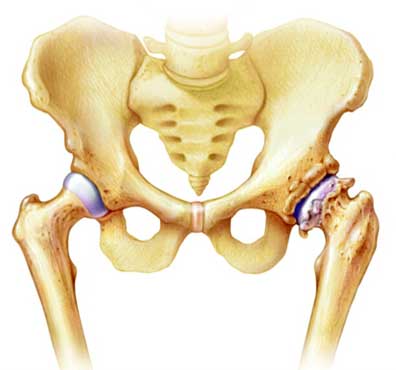
Hip Osteoarthritis (Degenerative Arthritis of the Hip)
 Many kinds of arthritis can affect the hip joint but the most common is osteoarthritis which some people call "degenerative joint disease." Osteoarthritis occurs when the protective cartilage on the ends of the bones wears down over time.
Many kinds of arthritis can affect the hip joint but the most common is osteoarthritis which some people call "degenerative joint disease." Osteoarthritis occurs when the protective cartilage on the ends of the bones wears down over time.
Types -
1. Primary: More generalized osteoarthritis that affects the fingers, thumbs, spine, hips, and knees
2. Secondary: Osteoarthritis that occurs after injury or inflammation in a joint, or as a result of another condition such as hemochromatosis
Risk factors -
Factors that increase risk of osteoarthritis include:
1. Older age- The risk of osteoarthritis increases with age.
2. Sex- Women are more likely to develop osteoarthritis
3. Bone deformities- Some people are born with malformed joints or defective cartilage, which can increase the risk of osteoarthritis.
4. Joint injuries- Injuries, such as those that occur when playing sports or from an accident
5. Obesity- Carrying more body weight puts added stress on your weight-bearing joints, such as knees.
6. Certain occupations- job includes tasks that place repetitive stress on a particular joint, that joint may eventually develop osteoarthritis.
7. Other diseases- Having diabetes, underactive thyroid, gout or Paget's disease of bone can increase risk of developing osteoarthritis.
Cause -
1. There may be genetic defects in the cartilage or possibly in the immune system, making it react abnormally to damage in the joint.
2. The person may be putting extra stress on joints, either by being overweight or through activities that involve the hip such as running or other intensive weight-bearing sports.
Symptoms -
Osteoarthritis symptoms often develop slowly and worsen over time.
1. Pain- During or after movement.
2. Tenderness- joint may feel tender when we apply light pressure to it.
3. Stiffness- Joint stiffness may be most noticeable in the morning or after a period of inactivity.
4. Loss of flexibility- decrease full range of motion.
5. Grating sensation- feel a grating sensation or crackling sound
6. Bone spurs- These extra bits of bone, which feel like hard lumps, may form around the affected joint.
7. Muscle wasting- loss of muscle bulk
Diagnose -
1. X-ray
Physiotherapy Treatment -
1. Soft tissue massage
2. Electrotherapy (e.g. US,SWD,IFT)
3. Mobilization
4. Ice or heat treatment
5. Exercises to improve strength, flexibility and balance
6. Hydrotherapy
7. Postural re-education
8. Crutches or the use of other walking aids
9. Walking re-education
10. Activity and lifestyle modification advice
11. Biomechanical correction
12. Anti-inflammatory and supplement advice (e.g. glucosamine and chondroitin sulfate)
13. Weight loss advice
14. Advice on appropriate footwear or orthotics

